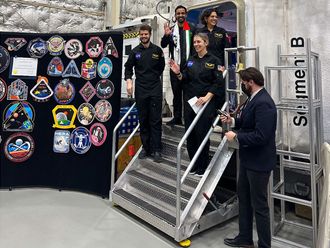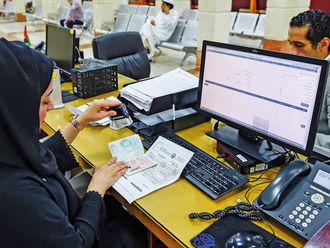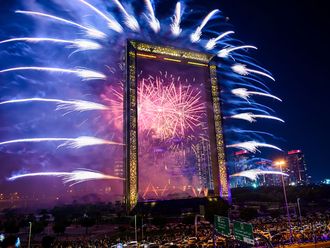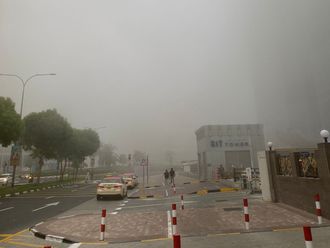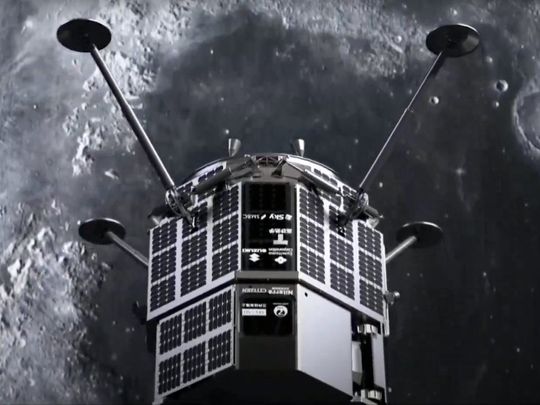
Dubai: In a fresh update issued on the Rashid Rover mission to the moon last night, the Mohammed Bin Rashid Space Centre (MBRSC) in Dubai has issued a statement saying: “ispace (the Japanese company that sent the lander spacecraft carrying the UAE’s Rashid Rover) confirmed that until 8am Japan time (3am UAE time), there was no communication between the HAKUTO-R lander and the mission control centre, and thus it was confirmed that there was no possibility of a successful landing on the Moon and contact with the lander.”
The lunar exploration company, ispace, said in a statement issued on Wednesday morning that the HAKUTO-R Mission 1 Lunar Lander was scheduled to touchdown on the surface of the Moon at approximately 1.40 am JST (8.40pm GST).
“As of 8am JST, April 26, 2023 (3am GST), the communication between the lander and the Mission Control Center was lost, although it was expected even after the touchdown, and it has been determined that Success 9 of the Mission Milestones is not achievable.”
The company thus determined that the lander could have made a hard landing.
“Based on the currently available data, the HAKUTO-R Mission Control Center in Nihonbashi, Tokyo, confirmed that the lander was in a vertical position as it carried out the final approach to the lunar surface. Shortly after the scheduled landing time, no data was received indicating a touchdown. ispace engineers monitored the estimated remaining propellant reached at the lower threshold and shortly afterward the descent speed rapidly increased. After that, the communication loss happened. Based on this, it has been determined that there is a high probability that the lander eventually made a hard landing on the Moon’s surface,” it said.
“To find the root cause of this situation, ispace engineers are currently working on a detailed analysis of the telemetry data acquired until the end of the landing sequence and will clarify the details after completing the analysis,” ispace added.
First Arab lunar mission to enter Moon's orbit
In a separate statement, MBRSC said: “Post the space announcement regarding the unsuccessful landing of HAKUTO-R Mission 1, the Mohammed Bin Rashid Space Centre commends the remarkable efforts of the mission partner ispace, who tirelessly worked towards the goal of landing safely on the lunar surface.
“While the Rashid Rover and other payloads onboard the lander did not get the chance to continue on their respective missions, the team at MBRSC is still proud of the achievements, including developing a rover and becoming the first Emirati and Arab lunar mission to enter the Moon’s orbit.
We thank the French space agency, CNES, for their scientific and technical contribution throughout the mission. We also appreciate the support of our local and international partners and the invaluable insights gained in the process. After getting this close to the Moon, the MBRSC team is inspired and believes that greater accomplishments are yet to come in our pursuit of space exploration.”
UAE’s second rover
Earlier in March, a top official of the Emirates Lunar Mission (EML) had revealed that the UAE was already working on a second rover to the Moon.
Dr Hamad Al Marzooqi, project manager, ELM, MBRSC, made the announcement while speaking at a plenary session on ‘MBRSC Missions: From Earth to Mars passing by Moon’ at the 17th International Conference on Space Operations (SpaceOps 2023) in Dubai.
Speaking to Gulf News on the sidelines of the conference, he confirmed that MBRSC is working on a new concept design for the next Moon rover. He said no name has been given to the rover yet as further details of the next mission have not firmed up yet.
“We are working on the concepts or the ideas and the objectives. The mission will be announced later, the name of the robot etc will come later,” he said.
Already a success
Pointing out that Moon landing is a high-risk mission, Al Marzooqi had back then said that MBRSC considers Rashid Rover to be a success irrespective of its landing success.
“Developing that mission, designing it from scratch, developing testing, and now preparing for operations, all these know-how is a success by itself,” he said
The second aspect is that it [offered] a successful international collaboration platform for us and that allowed us to open up opportunities for future missions as well… that is a success even before we land on the Moon.”
“Reaching to this critical moment of that mission with our partners is a successful moment by itself.”
So, he said whether the first rover will land successfully or not was not the focus as Moon-landing “is a risky business.”
“At MBRSC, we have started working and planning for the next rover before we know whether we are successful or not. So it's not the end. If we can call it a trial, yes, maybe it's a trial. But again, we use them to have a second, a third and so on.”
Designed and built by a core team of 11 Emirati engineers and scientists at MBRSC, the Rashid Rover was the world’s most compact rover meant to explore the moon. The solar-powered, four-wheel rover weighing just 10kg was equipped with four cameras.
The first lunar spacecraft built by an Arab country was named after the former Dubai Ruler, the late Sheikh Rashid bin Saeed Al Maktoum.
It was tasked with studying the properties of lunar soil, the petrography and geology of the Moon, dust movement, and study surface plasma conditions and the Moon's photoelectron sheath.
The lander carrying Rashid Rover had blasted off to space on a SpaceX Falcon 9 rocket from Cape Canaveral Space Force Station in Florida, the US, on December 11, 2022.
Rashid Rover is the first lunar exploration project under the Emirates Lunar Mission. ELM is funded by the ICT Fund of the Telecommunications and Digital Government Regulatory Authority (TDRA) which aims to support research and development in the ICT sector in the UAE.
Journey of exploration
The outcome of the Rashid rover landing marks only the beginning of a promising journey of exploration, Salem Humaid Al Marri, director general of MBRSC, said in a statement posted on Twitter on Wednesday.
He expressed his pride in the achievement made so far and thanked his colleagues and partners.
“Our colleagues have developed the first Emirati and Arab Rover; a notable achievement in and of itself and one we can all stand proudly behind. Thank you to the entire team for their unwavering devotion and hard work. We also thank our mission partners, ispace and CNES for their commendable efforts and their spirit of collaboration.”
Al Marri also pointed out how the UAE leaders have inspired others to take up challenges to make the impossible possible.
“Our leaders have taught us to achieve our goals through bold ambition and dedication. They encourage us to make the impossible possible. Challenges and difficulties are an inherent part of space missions, and particularly for lunar landings. By embarking on difficult missions, we learn, we improve and we progress,” he added.
Sarah Al Amiri, Chairwoman of the UAE Space Agency and Minister of State for Public Education and Advanced Technology, tweeted: "Hakuto-R lander was a pioneering concept, the first attempted landing on the moon by a private sector operator. Its loss has consequently meant the loss of the @MBRSpaceCentre Rashid Rover, which was to have explored new regions of the moon."
She added: "Years of hard work and dedication from the engineers @MBRSpaceCentre have not only further developed the capabilities and skillsets of the Emirates’ space sector, but have ensured that the whole sector has learned and moved ahead in leaps and bounds.
"We continue to have the opportunity to consolidate our work, learn from our setbacks and continue to strive to pursue ground-breaking space systems engineering, science and the development of our vibrant private space sector."



